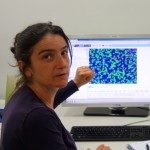Link to Pubmed [PMID] – 38493182
Link to DOI – 10.1186/s13567-024-01290-1
Vet Res 2024 Mar; 55(1): 32
Outbreaks of West Nile virus (WNV) occur periodically, affecting both human and equine populations. There are no vaccines for humans, and those commercialised for horses do not have sufficient coverage. Specific antiviral treatments do not exist. Many drug discovery studies have been conducted, but since rodent or primate cell lines are normally used, results cannot always be transposed to horses. There is thus a need to develop relevant equine cellular models. Here, we used induced pluripotent stem cells to develop a new in vitro model of WNV-infected equine brain cells suitable for microplate assay, and assessed the cytotoxicity and antiviral activity of forty-one chemical compounds. We found that one nucleoside analog, 2’C-methylcytidine, blocked WNV infection in equine brain cells, whereas other compounds were either toxic or ineffective, despite some displaying anti-viral activity in human cell lines. We also revealed an unexpected proviral effect of statins in WNV-infected equine brain cells. Our results thus identify a potential lead for future drug development and underscore the importance of using a tissue- and species-relevant cellular model for assessing the activity of antiviral compounds.

